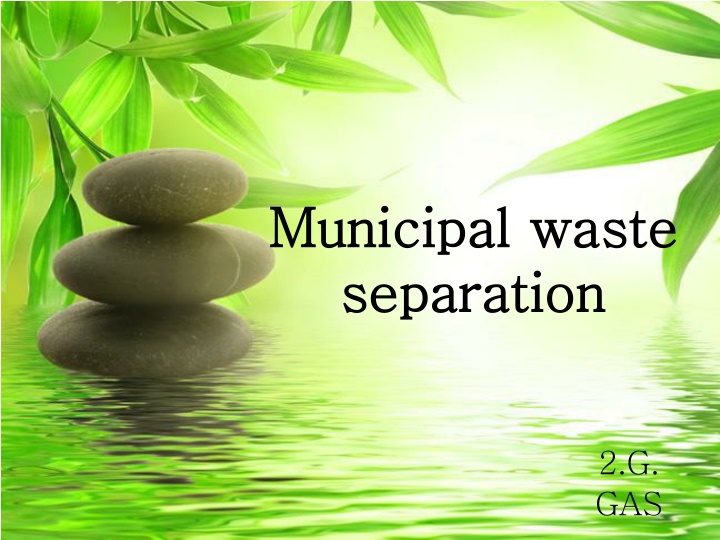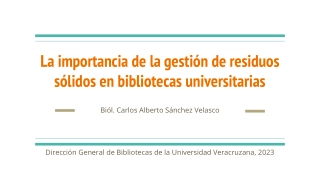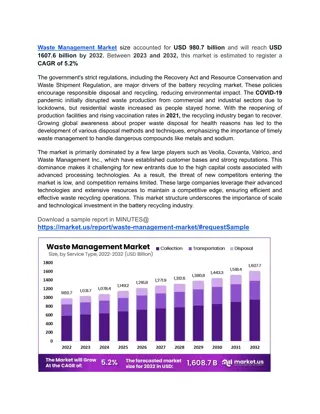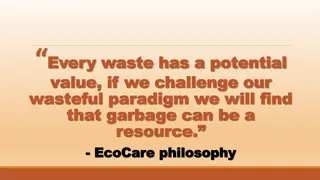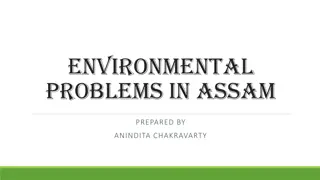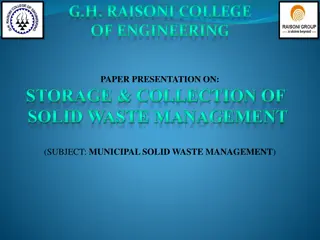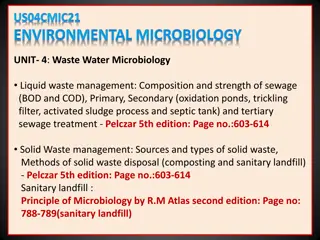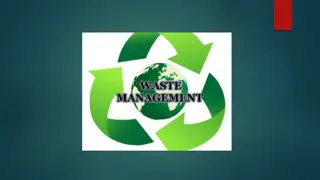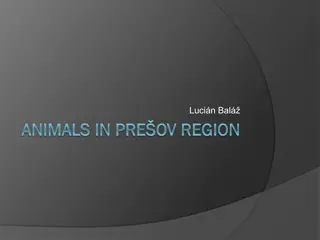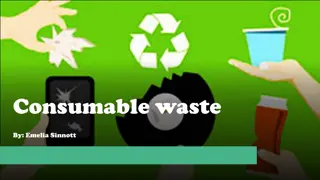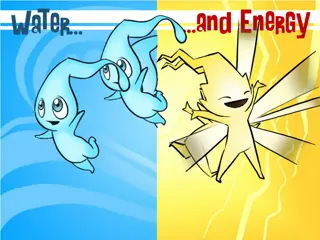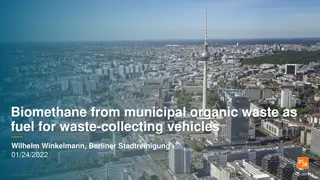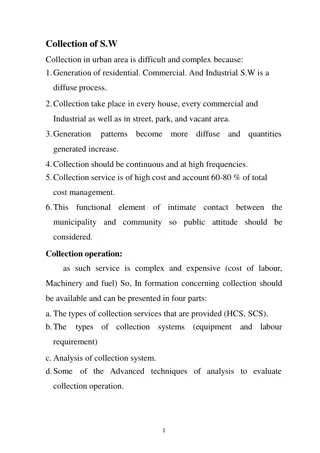Municipal Waste Separation in Slovakia: Challenges and Trends
The production of municipal waste in Slovakia has been on the rise, even during the pandemic. Despite spending more time at home, waste generation increased due to factors like home deliveries with disposable packaging. Waste generation varied by regions, with the west producing more waste than the east. Efforts towards waste separation and recycling are crucial to reduce environmental impact and enhance economic recovery of waste components.
Download Presentation

Please find below an Image/Link to download the presentation.
The content on the website is provided AS IS for your information and personal use only. It may not be sold, licensed, or shared on other websites without obtaining consent from the author.If you encounter any issues during the download, it is possible that the publisher has removed the file from their server.
You are allowed to download the files provided on this website for personal or commercial use, subject to the condition that they are used lawfully. All files are the property of their respective owners.
The content on the website is provided AS IS for your information and personal use only. It may not be sold, licensed, or shared on other websites without obtaining consent from the author.
E N D
Presentation Transcript
Municipal waste Municipal waste separation separation 2.G. GAS
Separation The purpose of separation is the economic recovery of separated waste components and at the same time reducing the amount of mixed waste. By sorting waste, people can contribute to environmental protection, which is very important to us.
Separation in Slovakia Separation in Slovakia Municipal waste production in Slovakia is growing. And it wasn't different in 2020, it was a year of pandemic, from which people expected the growth of waste production to slow down. In Slovakia, more waste was produced despite the lockdown, when people spent more time at home. In 2020, for every single person in Slovakia, there was 2.5% more municipal waste than in the record year of 2019
Separation in Slovakia Separation in Slovakia Why did waste production grow? Despite the fact that we spend more time at home during the lockdown, we cannot avoid the generation of waste. One example to explain the situation is the delivery of goods and meals to the doors of our homes packed in multi-layer and disposable packaging.
Separation in Slovakia Separation in Slovakia Most waste in the west, least in the east of Slovakia Waste generation in 2020 was different in each region. The highest amount of waste for each person was in the Trnava, Bratislava and Nitra regions. More than 500 kg of municipal waste for year. The least municipal waste was created last year by people from the regions of eastern Slovakia. In the Ko ice region it was 363 kg and in the Pre ov region 349 kg for each person .
Separation in Slovakia Separation in Slovakia Municipal waste Municipal waste production in kg production in kg- - person person Share of recovered Share of recovered municipal waste in municipal waste in % % Municipal waste Municipal waste recycling rate in % recycling rate in % Municipal waste Municipal waste recycling rate in % recycling rate in % Region, year 20220 Region, year 20220 Bratislavsk Bratislavsk 531 531 73,45 73,45 43,71 43,71 25,51 25,51 Trnavsk Trnavsk 584 584 47,25 47,25 47,22 47,22 52,73 52,73 Tren iansky Tren iansky 431 431 42,65 42,65 42,45 42,45 57,33 57,33 Nitriansky Nitriansky 521 521 44,71 44,71 44,69 44,69 55,25 55,25 ilinsk ilinsk 452 452 45,73 45,73 45,53 45,53 54,27 54,27 Banskobystrick Banskobystrick 392 392 43,46 43,46 43,45 43,45 56,54 56,54 Pre ovsk Pre ovsk 349 349 42,49 42,49 41,91 41,91 57,47 57,47 Ko ick Ko ick 363 363 66,76 66,76 39,36 39,36 33,24 33,24
Separation in Slovakia Separation in Slovakia On the other hand, the recycling rate was calculated at 43.7% and about 8% of municipal waste was recovered for electricity or heat in energy recovery facilities.
Separation in our school Separation in our school If we want to make Slovakia a more beautiful and healthier country, we need to help. Our school has decided to help support the separation project. In every class we have separation baskets and instructions on how to separate correctly. Because even if someone wants to sort waste but doesn t know how, his efforts are useless, because it hasn t got any effect.
Separation in our school Separation in our school Fortunately, separation becomes completely natural for students, sorting becomes an active part of our lives. A person who is aware of the importance of separation for nature translates his views into practical life. It becomes a living example of good behavior towards nature. Our grammar school contributes to the education of such a person.
Separation in companies Separation in companies Manufacturing companies and factories in Slovakia have to evaluate the report of disposal of waste, because this obligation arises from the law.
Separation in companies Separation in companies Their duty is to properly store waste in marked containers, mark it, and sort it according to the type of waste. The waste is passed on to companies, which valorize it, dispose it and process it as environmentally friendly as possible. For example old machine tires or plastic are crushed and mixed together for production of asphalt. Textile fents or old clothes are used, for example, in the production of textile fibers. In Krupina, many companies also have to sort waste. They have to pay fees for waste, which amount depends on the type and amount of waste. In companies that work with wood, there is also a large amount of waste that needs to be properly stored or processed. Pieces of wood that will no longer be needed in the manufacture of furniture are used for space heating or can be brought to the collection yard. Chips, shavings and sawdust are thrown into containers for biowaste, or into compost. Packaging in which wood always comes packed (plastic, cardboard, polystyrene) is thrown into bins designed for that.
Separation in our city Separation in our city General rules of waste management The waste collection system is declared a city system in the entire territory of the town of Krupina. It is strictly forbidden to move containers from designated places The city provides mass collection Collection, transport and places for disposal of bulky waste Collection and transport of bulky waste takes place at least twice a year The Municipal Office shall ensure that citizens are informed well in advance of the collection of bulky waste by special notification. Landfill during working hours and outside the time of organized collection of bulky waste by the city.
Green containers Green containers: non-returnable glass containers for beverages, glass containers, plate glass, glass shards,... Stained glass Do not throw! porcelain, ceramics, car glass, mirrors, TV screens,...
Yellow containers: bottles, cups, plastic bags, foils, polystyrene Plastic Do not throw! package from dangerous substances, for example motor oils, chemicals,...
Blue containers: newspaper, magazines, office paper, boxes, cartons,... Paper Do not throw! soiled paper, used diapers and hygienic products
Red containers: Metal covers, cans, metal products, aluminum foil Cans Do not throw! metal covers combined with other packaging, for example toothpaste
Brown containers biowaste Belongs here: biologic degradable waste from gardens, fruit and vegetable peels, coffee and tea residues
Black containers Mixed municipal waste: is unsorted waste or waste after sorting the components of municipal waste.
